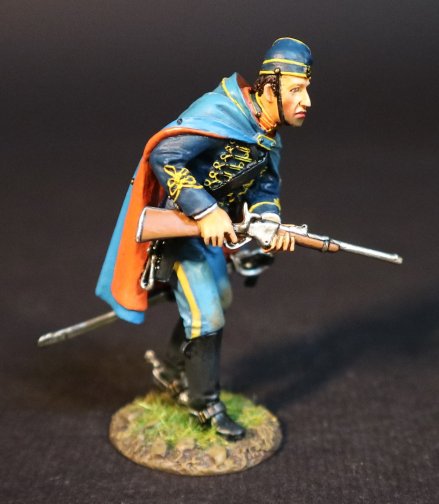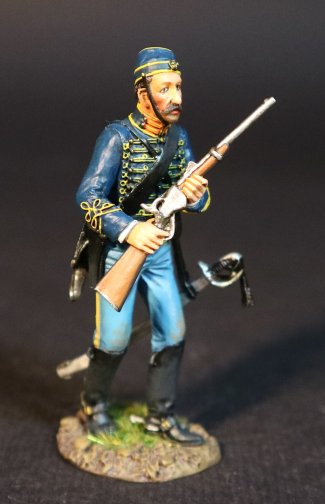- Joined
- Feb 2, 2011
- Messages
- 2,339
NEW RELEASES FOR APRIL 2024
THE AMERICAN CIVIL WAR
1[SUP]st[/SUP] CHEROKEE MOUNTED RIFLES
The 1[SUP]st[/SUP] Cherokee Mounted Rifles was a Confederate States Army regiment which fought in the Indian Territory during the American Civil War.
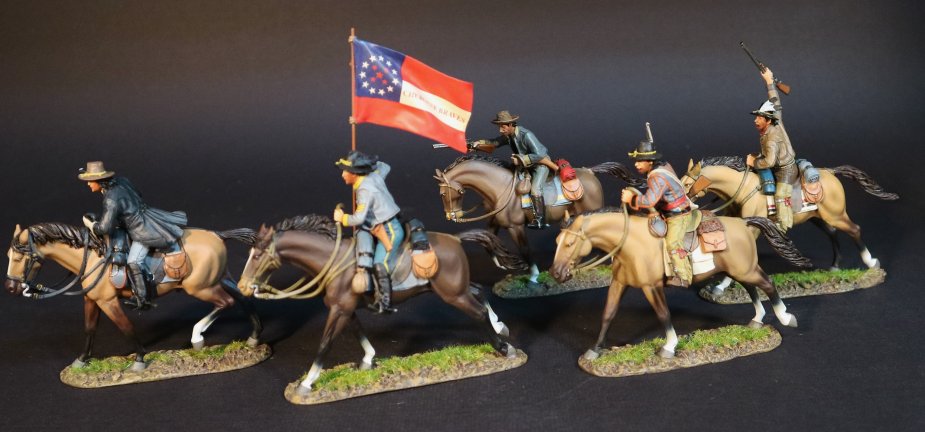
It was formed from the merger of two predecessor units, the First Regiment of Cherokee Mounted Rifles and the Second Regiment of Cherokee Mounted Rifles.
The first commander was Col. John Drew, while the commander of the second regiment was Stand Watie.

CHK-05
THE AMERICAN CIVIL WAR 1861 - 1865
THE CONFEDERATE ARMY,
1[SUP]st[/SUP] CHEROKEE MOUNTED RIFLES,
TROOPER
Brigadier-General Stand Watie (December 12[SUP]th[/SUP], 1806 – September 9[SUP]th[/SUP] 1871) was a Cherokee politician who served as the second principal chief of the Cherokee Nation from 1862 to 1866.
The Cherokee Nation allied with the Confederate States during the American Civil War and he was the only Native American Confederate General officer of the war.
Watie commanded the forces in the Trans-Mississippi Theatre, made up mostly of Cherokee, Muskogee and Seminole.
He was the last Confederate Staes Army general to surrender.
During the Civil War, Watie's troops participated in twenty-seven major engagements and numerous smaller skirmishes. Although some of the engagements were set-piece battles, most of their activities utilized guerrilla tactics.
The Battle of Pea Ridge (March 7-8[SUP]th[/SUP], 1862) took place near Leetown, northeast of Fayetteville, Arkansas.
Pea Ridge was the first sizable battle of the Civil War to involve Native American troops, mostly because their current homeland lay only a few miles west of the battlefield. These Tribes, including the Cherokee, had lived in the Indian Territory, now the state of Oklahoma, ever since their removal from ancestral homelands in the southeastern states a quarter-century before the war.
Watie’s Mounted Rifles welcomed the opportunity to participate in the Pea Ridge Campaign, as it was a chance to show they were a worthwhile ally of the Confederacy.
They were to make a colourful and controversial contribution. During the battle the two Cherokee regiments, perhaps 1,000 strong along with 200 Texas cavalry, charged and took a three gun Union artillery battery.
They swept out of the woods, knocking down a fence in front of them, and charged across the field, swarming over a three gun battery before the startled crews could respond. The artillerymen fled with their horses, leaving the guns behind unspiked.
At this point experienced, disciplined troops would have established security, or continued the pursuit of their fleeing enemy. Neither was done. Instead the Cherokee milled around the guns they had taken, examining their prizes and collecting souvenirs. Others exhaulted in having survived, yelling and whooping victoriously.
It was a normal reaction for green troops after a first experience of combat, and one that was often repeated throughout those early years of the war.
The failiure of the officers to take charge of the situation was to cost them the fruits of their victory.
While the celebrations were taking place, Union officers deployed two additional batteries and supporting infantry to retake the guns.
The exploits of Stand Watie and his Confederate Mounted Rifles were brilliant and militarily glorious, but strategically sterile. Two years of raids could not loosen the Union grip on Fort Gibson.
The Cherokees not only were the most numerous of the Five Tribes, but they had assimilated more with white culture than the Choctaw, Creek, Chickasaw, or Seminole. They were the only Native Americans to create a written form of their language and they published a newspaper in that language. Many Cherokees adopted the white man’s dress and most began to utilize American farming methods. Cherokee lawyers brought cases defending their desire to remain in Georgia and North Carolina to the United States Supreme Court. A handful of elite Cherokees operated large plantations with African-American slave labor.
ARTILLERY
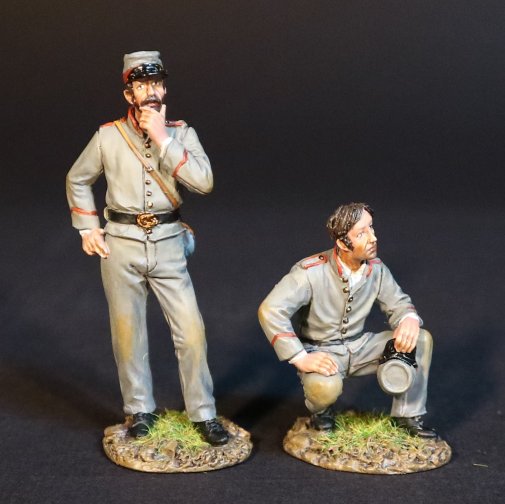
CSART-18
THE AMERICAN CIVIL WAR 1861 - 1865
CONFEDERATE ARTILLERY,
ARTILLERY CREW
THE BATTLE OF BRANDY STATION, JUNE 9[SUP]th[/SUP], 1863
UNION CAVALRY ,CHARGING
The Battle Of Brandy Station, also called the Battle of Fleetwood Hill, was the largest predominantly cavalry engagement of the American Civil War, as well as the largest ever to take place on American soil. It was fought on June 9[SUP]th[/SUP], 1863, around Brandy Station, Virginia at the beginning of the Gettysburg Campaign by the Union cavalry under Maj.Gen. Alfred Pleasonton against Maj. Gen. J.E.B. Stuart’s Confederate cavalry.
After an all day fight in which fortunes changed repeatedly, the Federals retired without discovering Gen. Robert E. Lee’s infantry camped near Culpeper. This battle marked the end of the Confederate cavalry’s dominance in the East.
From this point in the war the Federal cavalry gained strength and confidence.

The Battle saw nine thousand Union cavalrymen and three thousand Union infantry clash with ten thousand Confederate horsemen. The fighting lasted for roughly twelve hours and covered dozens of square miles.
Unknown to the Confederates, 12,000 Union men had massed on the other side of the Rappahannock River.
Maj. Gen. Alfred Pleasonton, commanding the Cavalry Corps of the Army of The Potomac, had organized his combined armed forces into two wings, under Brig. Gen. John Buford and David McMurtrie Gregg, augmented by infantry brigades from the V Corps.
Buford’s wing, accompanied by Pleasonton, consisted of his own 1[SUP]st[/SUP] Cavalry Division, a reserve brigade led by Maj. Charles J. Whiting, and an infantry brigade of 3,000 men under Brig. Gen. Adelbert Ames.
Gregg’s wing was the 2[SUP]nd[/SUP] Cavalry Division, led by Col. Alfred N. Duffie, the 3[SUP]rd[/SUP] Cavalry Division led by Gregg, and an infantry brigade under Brig. Gen. David A. Russell.
The commander of the Army of the Potomac, Maj. Gen. Joseph Hooker, interpreted the enemy’s cavalry presence around Culpeper to be indicative of preparations for a raid of his army’s supply lines. In reaction to this, he ordered Pleasonton’s force on a “spoiling raid”, to “disperse and destroy” the Confederates.
Pleasonton’s attack plan called for a two-pronged thrust at the enemy. Buford’s wing would cross the river at Beverly’s Ford, two miles northeast of Brandy Station, at the same time, Gregg would cross at Kelly’s Ford, six miles downstream to the southeast.
Pleasonton anticipated that the Southern cavalry would be caught in a double envelopment, surprised, outnumbered, and beaten.
He was, however, unaware of the precise disposition of the enemy and he incorrectly assumed that his force was substantially larger than the Confederates he faced.
Both sides at Brandy Station were armed in a similar manner. For mounted combat, cavalrymen carried light cavalry sabers and pistols. Some Confederate cavalry carried more than one pistol, or a shotgun, and basically used what they could get a hold of.
In a melee or skirmish, there was no intrinsic superiority of pistol over a saber. Even an excellent shot found hitting a moving mounted enemy target difficult, and sabers had the advantage they did not need to be reloaded. The saber had the advantage of intimidation during a charge, with many defenders breaking when faced by a crowd of riders waving sabers, even before the charging troops reached them.
A typical cavalry charge against cavalry was a relatively rare occurrence, usually with one side or the other breaking and bolting before contact. If hand to hand combat ensued, the fighting was confusing, vicious and protracted. If one side committed reserve squadrons to the fray, they often carried the day.

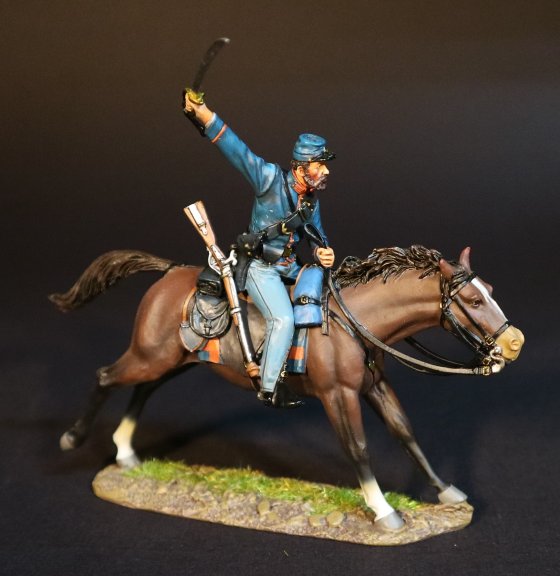
USBS2-06
THE AMERICAN CIVIL WAR 1861 - 1865
THE BATTLE OF BRANDY STATION, JUNE 9[SUP]th[/SUP], 1863,
THE ARMY OF THE POTOMAC,
CAVALRY CORPS,
2[SUP]nd[/SUP] US CAVALRY REGIMENT

USBS-06
THE AMERICAN CIVIL WAR 1861 - 1865
THE BATTLE OF BRANDY STATION, JUNE 9[SUP]th[/SUP], 1863,
THE ARMY OF THE POTOMAC,
CAVALRY CORPS
UNION CAVALRY
THE AMERICAN CIVIL WAR
1[SUP]st[/SUP] CHEROKEE MOUNTED RIFLES
The 1[SUP]st[/SUP] Cherokee Mounted Rifles was a Confederate States Army regiment which fought in the Indian Territory during the American Civil War.

It was formed from the merger of two predecessor units, the First Regiment of Cherokee Mounted Rifles and the Second Regiment of Cherokee Mounted Rifles.
The first commander was Col. John Drew, while the commander of the second regiment was Stand Watie.

CHK-05
THE AMERICAN CIVIL WAR 1861 - 1865
THE CONFEDERATE ARMY,
1[SUP]st[/SUP] CHEROKEE MOUNTED RIFLES,
TROOPER
Brigadier-General Stand Watie (December 12[SUP]th[/SUP], 1806 – September 9[SUP]th[/SUP] 1871) was a Cherokee politician who served as the second principal chief of the Cherokee Nation from 1862 to 1866.
The Cherokee Nation allied with the Confederate States during the American Civil War and he was the only Native American Confederate General officer of the war.
Watie commanded the forces in the Trans-Mississippi Theatre, made up mostly of Cherokee, Muskogee and Seminole.
He was the last Confederate Staes Army general to surrender.
During the Civil War, Watie's troops participated in twenty-seven major engagements and numerous smaller skirmishes. Although some of the engagements were set-piece battles, most of their activities utilized guerrilla tactics.
The Battle of Pea Ridge (March 7-8[SUP]th[/SUP], 1862) took place near Leetown, northeast of Fayetteville, Arkansas.
Pea Ridge was the first sizable battle of the Civil War to involve Native American troops, mostly because their current homeland lay only a few miles west of the battlefield. These Tribes, including the Cherokee, had lived in the Indian Territory, now the state of Oklahoma, ever since their removal from ancestral homelands in the southeastern states a quarter-century before the war.
Watie’s Mounted Rifles welcomed the opportunity to participate in the Pea Ridge Campaign, as it was a chance to show they were a worthwhile ally of the Confederacy.
They were to make a colourful and controversial contribution. During the battle the two Cherokee regiments, perhaps 1,000 strong along with 200 Texas cavalry, charged and took a three gun Union artillery battery.
They swept out of the woods, knocking down a fence in front of them, and charged across the field, swarming over a three gun battery before the startled crews could respond. The artillerymen fled with their horses, leaving the guns behind unspiked.
At this point experienced, disciplined troops would have established security, or continued the pursuit of their fleeing enemy. Neither was done. Instead the Cherokee milled around the guns they had taken, examining their prizes and collecting souvenirs. Others exhaulted in having survived, yelling and whooping victoriously.
It was a normal reaction for green troops after a first experience of combat, and one that was often repeated throughout those early years of the war.
The failiure of the officers to take charge of the situation was to cost them the fruits of their victory.
While the celebrations were taking place, Union officers deployed two additional batteries and supporting infantry to retake the guns.
The exploits of Stand Watie and his Confederate Mounted Rifles were brilliant and militarily glorious, but strategically sterile. Two years of raids could not loosen the Union grip on Fort Gibson.
The Cherokees not only were the most numerous of the Five Tribes, but they had assimilated more with white culture than the Choctaw, Creek, Chickasaw, or Seminole. They were the only Native Americans to create a written form of their language and they published a newspaper in that language. Many Cherokees adopted the white man’s dress and most began to utilize American farming methods. Cherokee lawyers brought cases defending their desire to remain in Georgia and North Carolina to the United States Supreme Court. A handful of elite Cherokees operated large plantations with African-American slave labor.
ARTILLERY

CSART-18
THE AMERICAN CIVIL WAR 1861 - 1865
CONFEDERATE ARTILLERY,
ARTILLERY CREW
THE BATTLE OF BRANDY STATION, JUNE 9[SUP]th[/SUP], 1863
UNION CAVALRY ,CHARGING
The Battle Of Brandy Station, also called the Battle of Fleetwood Hill, was the largest predominantly cavalry engagement of the American Civil War, as well as the largest ever to take place on American soil. It was fought on June 9[SUP]th[/SUP], 1863, around Brandy Station, Virginia at the beginning of the Gettysburg Campaign by the Union cavalry under Maj.Gen. Alfred Pleasonton against Maj. Gen. J.E.B. Stuart’s Confederate cavalry.
After an all day fight in which fortunes changed repeatedly, the Federals retired without discovering Gen. Robert E. Lee’s infantry camped near Culpeper. This battle marked the end of the Confederate cavalry’s dominance in the East.
From this point in the war the Federal cavalry gained strength and confidence.

The Battle saw nine thousand Union cavalrymen and three thousand Union infantry clash with ten thousand Confederate horsemen. The fighting lasted for roughly twelve hours and covered dozens of square miles.
Unknown to the Confederates, 12,000 Union men had massed on the other side of the Rappahannock River.
Maj. Gen. Alfred Pleasonton, commanding the Cavalry Corps of the Army of The Potomac, had organized his combined armed forces into two wings, under Brig. Gen. John Buford and David McMurtrie Gregg, augmented by infantry brigades from the V Corps.
Buford’s wing, accompanied by Pleasonton, consisted of his own 1[SUP]st[/SUP] Cavalry Division, a reserve brigade led by Maj. Charles J. Whiting, and an infantry brigade of 3,000 men under Brig. Gen. Adelbert Ames.
Gregg’s wing was the 2[SUP]nd[/SUP] Cavalry Division, led by Col. Alfred N. Duffie, the 3[SUP]rd[/SUP] Cavalry Division led by Gregg, and an infantry brigade under Brig. Gen. David A. Russell.
The commander of the Army of the Potomac, Maj. Gen. Joseph Hooker, interpreted the enemy’s cavalry presence around Culpeper to be indicative of preparations for a raid of his army’s supply lines. In reaction to this, he ordered Pleasonton’s force on a “spoiling raid”, to “disperse and destroy” the Confederates.
Pleasonton’s attack plan called for a two-pronged thrust at the enemy. Buford’s wing would cross the river at Beverly’s Ford, two miles northeast of Brandy Station, at the same time, Gregg would cross at Kelly’s Ford, six miles downstream to the southeast.
Pleasonton anticipated that the Southern cavalry would be caught in a double envelopment, surprised, outnumbered, and beaten.
He was, however, unaware of the precise disposition of the enemy and he incorrectly assumed that his force was substantially larger than the Confederates he faced.
Both sides at Brandy Station were armed in a similar manner. For mounted combat, cavalrymen carried light cavalry sabers and pistols. Some Confederate cavalry carried more than one pistol, or a shotgun, and basically used what they could get a hold of.
In a melee or skirmish, there was no intrinsic superiority of pistol over a saber. Even an excellent shot found hitting a moving mounted enemy target difficult, and sabers had the advantage they did not need to be reloaded. The saber had the advantage of intimidation during a charge, with many defenders breaking when faced by a crowd of riders waving sabers, even before the charging troops reached them.
A typical cavalry charge against cavalry was a relatively rare occurrence, usually with one side or the other breaking and bolting before contact. If hand to hand combat ensued, the fighting was confusing, vicious and protracted. If one side committed reserve squadrons to the fray, they often carried the day.


USBS2-06
THE AMERICAN CIVIL WAR 1861 - 1865
THE BATTLE OF BRANDY STATION, JUNE 9[SUP]th[/SUP], 1863,
THE ARMY OF THE POTOMAC,
CAVALRY CORPS,
2[SUP]nd[/SUP] US CAVALRY REGIMENT

USBS-06
THE AMERICAN CIVIL WAR 1861 - 1865
THE BATTLE OF BRANDY STATION, JUNE 9[SUP]th[/SUP], 1863,
THE ARMY OF THE POTOMAC,
CAVALRY CORPS
UNION CAVALRY





